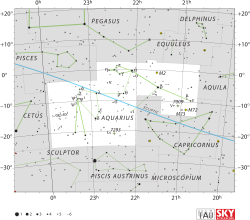Eta Aquarii

| |
| Observation data Epoch J2000 Equinox J2000 | |
|---|---|
| Constellation | Aquarius |
| Right ascension | 22h 35m 21.38126s[1] |
| Declination | –00° 07′ 02.9888″[1] |
| Apparent magnitude (V) | 4.04[2] |
| Characteristics | |
| Spectral type | B9IV-Vn[3] |
| U−B color index | –0.28[4] |
| B−V color index | –0.10[4] |
| Astrometry | |
| Radial velocity (Rv) | –8.0[2] km/s |
| Proper motion (μ) | RA: +89.74[1] mas/yr Dec.: –56.10[1] mas/yr |
| Parallax (π) | 19.43 ± 0.25[1] mas |
| Distance | 168 ± 2 ly (51.5 ± 0.7 pc) |
| Details | |
| Radius | 2.9[5] R☉ |
| Temperature | 11,219 ± 82[5] K |
| Rotational velocity (v sin i) | 291[6] km/s |
| Other designations | |
Eta Aquarii (η Aqr, η Aquarii) is the Bayer designation for a star in the equatorial constellation of Aquarius. It is visible to the naked eye with an apparent visual magnitude of 4.04.[2] The distance to this star, as determined by parallax measurements, is about 168 light-years (52 parsecs).[1] Eta Aquarii is near the radiant of a meteor shower named after it.
Eta Aquarii has a stellar classification of B9IV-Vn,[3] which may indicate that it is beginning to evolve away from the main sequence into a subgiant as the supply of hydrogen at its core becomes exhausted. It is spinning rapidly with a high projected rotational velocity of 291 km/s.[6] This is causing an equatorial bulge, giving the star an oblate figure with a 24% larger radius at the equator than at the poles.[8] The Doppler effect from the rapid rotation is causing the absorption lines in the star's spectrum to blur, as indicated by the 'n' suffix in the star's classification.
Etymology
This star sometimes called with the name Hydria, from the Greek word ‘υδρια (hudria), meaning "water jar".[9] Another name of this star is Deli, derived from Hebrew word דלי (dali) literally meaning "hard".[10]
This star, along with γ Aqr (Sadachbia), π Aqr (Seat) and ζ Aqr (Sadaltager / Achr al Achbiya), were al Aḣbiyah (الأخبية), the Tent.[11][12][13]
In Chinese, 墳墓 (Fén Mù), meaning Tomb, refers to an asterism consisting of η Aquarii, γ Aquarii, ζ Aquarii, π Aquarii.[14] Consequently, η Aquarii itself is known as 墳墓三 (Fén Mù sān, English: the Third Star of Tomb.)[15]
References
- 1 2 3 4 5 6 van Leeuwen, F. (November 2007), "Validation of the new Hipparcos reduction", Astronomy and Astrophysics, 474 (2): 653–664, arXiv:0708.1752
 , Bibcode:2007A&A...474..653V, doi:10.1051/0004-6361:20078357.
, Bibcode:2007A&A...474..653V, doi:10.1051/0004-6361:20078357. - 1 2 3 Wielen, R.; et al. (1999), Sixth Catalogue of Fundamental Stars (FK6). Part I. Basic fundamental stars with direct solutions (35), Astronomisches Rechen-Institut Heidelberg, Bibcode:1999VeARI..35....1W.
- 1 2 Cowley, A. (November 1972), "Spectral classification of the bright B8 stars", Astronomical Journal, 77: 750–755, Bibcode:1972AJ.....77..750C, doi:10.1086/111348.
- 1 2 Johnson, H. L.; et al. (1966), "UBVRIJKL photometry of the bright stars", Communications of the Lunar and Planetary Laboratory, 4 (99), Bibcode:1966CoLPL...4...99J.
- 1 2 Underhill, A. B.; et al. (November 1979), "Effective temperatures, angular diameters, distances and linear radii for 160 O and B stars", Monthly Notices of the Royal Astronomical Society, 189: 601–605, Bibcode:1979MNRAS.189..601U, doi:10.1093/mnras/189.3.601.
- 1 2 Royer, F.; Zorec, J.; Gómez, A. E. (February 2007), "Rotational velocities of A-type stars. III. Velocity distributions", Astronomy and Astrophysics, 463 (2): 671–682, arXiv:astro-ph/0610785
 , Bibcode:2007A&A...463..671R, doi:10.1051/0004-6361:20065224.
, Bibcode:2007A&A...463..671R, doi:10.1051/0004-6361:20065224. - ↑ "eta Aqr -- Star", SIMBAD Astronomical Object Database, Centre de Données astronomiques de Strasbourg, retrieved 2012-06-30.
- ↑ van Belle, Gerard T. (March 2012), "Interferometric observations of rapidly rotating stars", The Astronomy and Astrophysics Review, 20 (1): 51, arXiv:1204.2572
 , Bibcode:2012A&ARv..20...51V, doi:10.1007/s00159-012-0051-2.
, Bibcode:2012A&ARv..20...51V, doi:10.1007/s00159-012-0051-2. - ↑ (Turkish) YILDIZ ADLARI SÖZLÜĞÜ - Mustafa Pultar (Hydria)
- ↑ (Turkish) YILDIZ ADLARI SÖZLÜĞÜ - Mustafa Pultar (Deli)
- ↑ Davis Jr., G. A., "The Pronunciations, Derivations, and Meanings of a Selected List of Star Names,"Popular Astronomy, Vol. LII, No. 3, Oct. 1944, p. 12.
- ↑ Allen, R. H. (1963). Star Names: Their Lore and Meaning (Reprint ed.). New York: Dover Publications Inc. p. 52. ISBN 0-486-21079-0. Retrieved 2010-12-12.
- ↑ γ Aqr as Aoul al Achbiya or Prima Tabernaculorum (the first of luck of the homes or tents), π Aqr as Wasat al Achbiya or Media Tabernaculorum (the middle of luck of the homes or tents) and ζ Aqr as Achr al Achbiya or Postrema Tabernaculorum (the end of luck of the homes or tents). η Aqr should be designated as al Achbiya consistently, but it was not designated as the Arabian name except the name Hydria (Greek) or Deli (Hebrew)
- ↑ (Chinese) 中國星座神話, written by 陳久金. Published by 台灣書房出版有限公司, 2005, ISBN 978-986-7332-25-7.
- ↑ (Chinese) AEEA (Activities of Exhibition and Education in Astronomy) 天文教育資訊網 2006 年 5 月 16 日